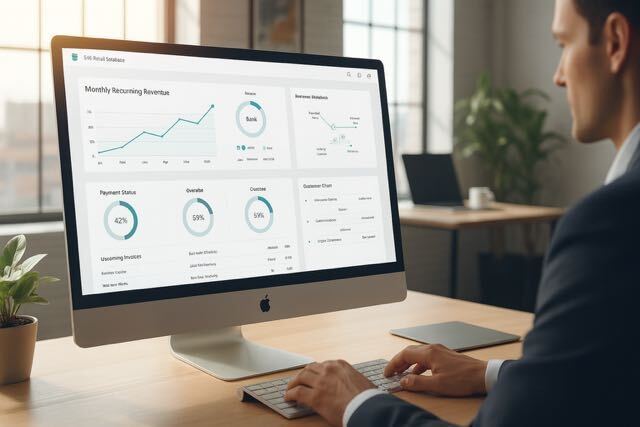MSP SEO: How to Use SEO to Grow Your MSP Business

In our previous post, we outlined many strategies for managed service providers (MSPs) to generate more leads for their business.
One of the most crucial channels we recommended focusing on was search engine optimization (SEO). When used correctly, SEO has immense potential to drive sustainable growth for MSPs by increasing their visibility online.
In this post, we'll dive deep into how MSPs can leverage SEO as a growth strategy. We'll cover the importance of SEO for MSP, how it’s different from PPC, and how to get started.
Let’s dive right in!
What is MSP SEO?
SEO stands for search engine optimization. In simple terms, MSP SEO refers to optimizing your managed service provider (MSP) website and complete online presence specifically to rank higher on search engines like Google.
But you don’t get business just by ranking higher — the game is more about ranking for the right keywords. The goal of MSP SEO is to get your website in front of your ideal customers.
This means you should appear whenever they search for IT and technology services related to your offerings. We're talking about attracting local business leaders and decision-makers who are looking for managed IT solutions like yours.
With effective SEO, you can drive targeted, relevant traffic to your site — visitors who are more likely to fill out your contact form and enter your sales funnel.
And you can do this without relying solely on paid search ads. MSP SEO focuses on organic search results - the free listings that appear because your content and pages match what searchers are looking for.
Why should MSPs care about SEO?
When there are tactics like email marketing, social media, advertising and others, here are some reasons why we recommend focusing on SEO too:
1. Build your audience organically
One of the most significant benefits of SEO for MSPs is the ability to grow an audience and generate leads without relying solely on expensive advertising and marketing campaigns.
Focusing on SEO and optimizing content and pages can attract more organic search traffic from your ideal customers over time. This incoming traffic and leads from SEO efforts is more qualified, too, since visitors are actively searching for your services.
With SEO, you can build a pipeline of leads month after month from relevant search queries without paying per click or impression.
The compounding effects of consistently publishing new, optimized content result in a website that ranks for dozens or even hundreds of keywords related to your MSP offerings. Each new piece of content expands your organic reach and visibility.
2. Earn high-value leads
Every new customer acquired through organic SEO represents an excellent ROI for MSPs. The B2B SaaS industry has a mind-boggling SEO ROI of 702%.
With the high-profit business model of managed services, leads gained through SEO have immense value given the lifetime value of an MSP client relationship.
On average, MSP clients stay for 3-7 years and provide recurring revenue through managed services and support plans.
Just a few new MSP clients from SEO each month can significantly impact your revenue when you factor in the long-term value of each client.
One new $2,000 MRR client from SEO can result in $60,000 or more in lifetime value. The ROI from SEO blows other lead generation methods out of the water.
3. Target multiple customer types
A key advantage of SEO for MSPs is the ability to target multiple customer segments if you offer a wide range of IT and technology services.
For example, you can create optimized content for healthcare companies, financial services, municipalities, manufacturing, professional services, and more.
You’re likely to service small, mid-market, and enterprise clients — SEO allows you to reach decision-makers in all these sectors. The broader your service offering, the wider your SEO visibility and lead generation can be. You aren't niche-locked and can sometimes benefit from casting a wider net.
4. Gain trust and authority
By consistently publishing high-quality content optimized for relevant SEO keywords, MSPs can build brand awareness, trust, and thought leadership in their market.
SEO enhances your discoverability and positions your brand as an authority that prospects can rely on.
Optimized thought leadership content shows you understand your customer's pain points and can provide the solutions they need. This helps convert more leads when they find you through organic search. Being seen as a trusted resource makes sales conversations much more manageable.
5. Future-proof your marketing
SEO delivers long-term ROI and stability to MSP lead gen efforts. Unlike paid ads, organic rankings are a more permanent asset that continues to generate leads and traffic over time.
SEO success this year will continue benefiting your MSP for years to come with little to no added effort. Traffic and conversions continue even if you pause your SEO efforts.
SEO also provides lasting results regardless of economic conditions or marketing budget cuts. Organic lead generation through SEO future-proofs your marketing.
5. Outperform your competition
Most MSPs still underutilize SEO in their marketing. By focusing on SEO, you can outperform competitors in organic search results, stand out online, and divert leads away from other providers vying for the same local customers.
If done right, SEO is a competitive advantage compared to MSPs who only use paid advertising and outbound sales tactics. You can dominate the market by owning keywords prospects search for when making MSP hiring decisions.
Difference b/w PPC and SEO for MSP
SEO and PPC for MSPs serve different purposes and have distinct characteristics. SEO is a long-term, cost-effective strategy focusing on organic rankings, while PPC delivers immediate results but requires a budget and ongoing expenses.
Here are the key differences between the two:
If you want to achieve the best possible outcome in growing your MSP business, using SEO and PPC in tandem is often the most effective. Combining the strengths of both strategies can create a well-rounded online marketing approach.
How to get started with MSP SEO?
It might look complicated from a distance, but getting started with SEO is not as complex. Follow the steps below to start SEO-based MSP marketing campaigns with a bang:
1. Define your goals and choose KPIs
Before starting your MSP SEO strategy, clearly define your goals so you can properly track progress.
Do you aim to increase website traffic, generate more leads, boost online revenue, or a combination? Choose 1-3 concrete goals.
Then, identify key performance indicators (KPIs) to monitor for each goal. KPIs for website traffic could include organic users, new sessions, and page views. For lead generation, monitor form submissions, calls, and demos requested. Revenue KPIs include online conversions, average order value, and online sales.
Monitoring these MSP KPIs and goals will ensure that your MSP SEO journey is on the right track.
2. Research and select your target keywords
Conduct thorough keyword research to identify relevant target keywords and phrases. Use planning tools to analyze search volume data and competition levels.
Search for topics your ideal prospects are likely searching for during their IT services buying journey. For example, "managed IT services cloud solutions," "MSP pricing," "choosing an MSP," and "MSP reviews." Build a comprehensive keyword list focused on high-value topics related to your offerings. Also, don’t use vague language or low-volume keywords at any cost.
3. Analyze keyword difficulty and competition
For each target keyword, analyze the competition and difficulty of ranking. Keyword difficulty scores account for current ranking sites' authority and optimization levels.
Choose keywords with medium-to-high search volume but low difficulty for focus. Avoid highly competitive keywords initially.
Also, research which pages and domains rank for your targets to inform your content strategy.
4. Optimize title tags and meta descriptions
Keyword optimization starts with page titles and meta descriptions. Include your primary keyword for each page near the start of the title tag. This helps search engines understand the page's focus.
In the meta description, provide a compelling summary of the content highlighting your abilities as an MSP. Descriptions don't directly impact rankings but can improve click-through rates.
5. Optimize headers, content, and alt text for keywords
When optimizing your pages for specific keywords, be strategic with where you place them throughout the content.
Use your primary keywords in the H1 and H2 header tags to clearly indicate the overall page topic and structure to search engines.
Also, organically work your keywords into the body content in a natural density of 1-5% so they don't appear forced.
For images, always fill out the alt text attribute with a description that includes the relevant keyword. This tells search bots what the visual content illustrates.
Be subtle with keyword placement - you don't want to over-optimize and compromise readability. When done properly, on-page optimization reinforces relevance and establishes your MSP as an authority.
6. Follow technical on-page SEO best practices
Beyond keywords, follow vital technical SEO practices. Ensure fast page speed through optimization. Make your website 100% mobile-friendly because no matter which industry your MSP serves, a significant number of potential clients will search for you via mobile browsers.
To give a better user experience and get in Google’s good books — implement proper URL structures, sitemaps, and internal linking. Add structured data markup and fix any crawling errors reported in the Search Console.
7. Enhance local SEO signals and listings
For MSPs targeting local markets, strengthening your local SEO signals should be a priority.
Prominently display your business name, address, and phone numbers using consistent NAP formatting on your website and Google My Business listing. This helps search engines understand your geographic service area.
You should also request customer reviews on Google, Facebook, and directories like Yelp to showcase the locality.
Also, implement local schema markup on your website for enhanced clarity. Solidifying these crucial local SEO foundations improves visibility and conversions from local potential clients looking for your services.
8. Claim and optimize your Google My Business profile
Ensure that you claim your Google My Business (GMB) listing to boost visibility on Google search and maps. This free profile essentially functions as your digital storefront on Google.
You must also optimize your GMB profile completely with keyword-rich descriptions of your services, business categories that apply, and photos and videos that showcase your team and office.
Leverage GMB posts and messaging to engage visitors. By monitoring and responding to reviews, your MSP can establish trust.
9. Produce optimized, high-quality content pillars
One of the most effective ongoing SEO tactics is producing pillar content optimized with your keywords.
These comprehensive “pillar” guides provide immense value on topics your audience cares about. For example, an MSP could create a pillar on “The Complete Guide to Choosing a Managed IT Service Provider” with sections covering pricing, services, transitioning, and more.
When you promote your pillar content across marketing channels and distribute links wherever possible and relevant, your MSP gets recognition for thought leadership and expertise, which helps bring more business.
MSP SEO mistakes to avoid
As with any growth strategy, there are plenty of pitfalls and mistakes to avoid with SEO. Here are some key errors that managed service providers should steer clear of:
1. Avoid random, irrelevant keywords: Stuffing random keywords will not improve rankings and may even trigger spam filters. Ensure all optimized keywords are relevant to your MSP services and the page topic. This establishes topical authority.
2. Don't over-optimize with keyword stuffing: Avoid aggressively over-optimizing pages by repeatedly stuffing the exact keywords in unnatural density. This violates Google's quality guidelines. Use keywords sparingly where they fit naturally.
3. Prioritize relevance before keyword density: While keyword density matters, relevancy is even more critical for quality content. Aim for 1-5% density, but don't force keywords if they don't fit organically. Readers value informative content more than heavy keyword placement.
4. Avoid highly competitive, broad keywords: When researching keyword targets, beware of choosing high-competition, short, broad keywords. For example, “managed IT services” is highly competitive for most MSPs. Instead, target longer, more specific long-tail keyword variations with lower difficulty. This gives your content more room to rank.
5. Don't reuse keywords across your site: Avoid reusing the exact same keyword phrases across multiple pages on your site. This causes self-competition, whereby pages dilute each other's ability to rank well.
6. Optimize for conversational long-tail keywords: Rather than short, broad keywords only, optimize for conversational long-tail variations like "How to choose an MSP in Houston." These align closer to natural search queries.
7. Avoid automating SEO: Completely automating SEO through generic tactics without custom optimization for pages dilutes effectiveness over time. Manual oversight and refinement based on performance data are key. Don't take an entirely hands-off approach.
On a concluding note
Using SEO will surely bring leads for your MSP in the long run, but your business will see true growth only if you convert a maximum of those leads.
Converting leads requires managing your leads in a methodical way and following up with them in a timely manner. That’s where Zomentum comes in, the all-in-one platform for MSP businesses to manage their leads, prospects, clients and the relationship with each, to optimize the sales cycle for increased revenue.
Want to know more? Book a demo today!





.png)









